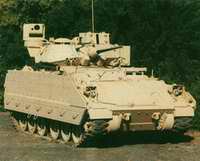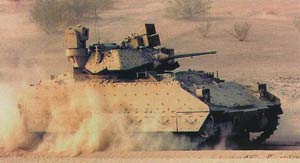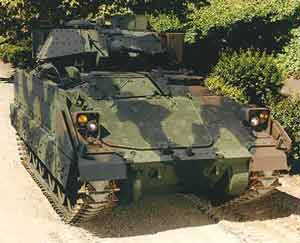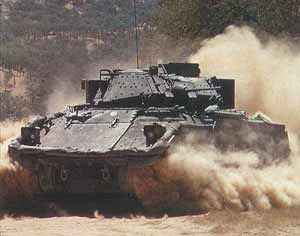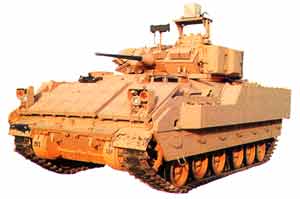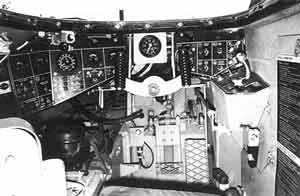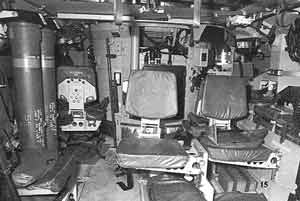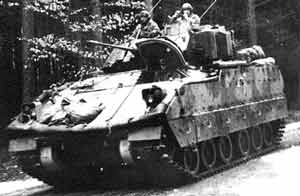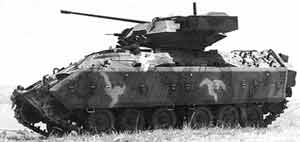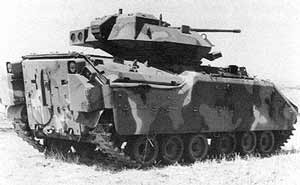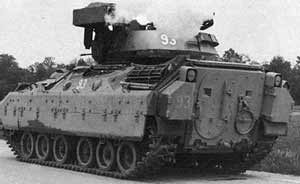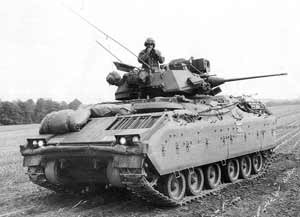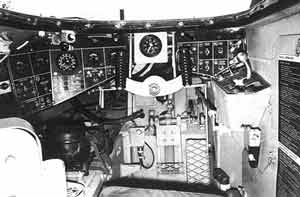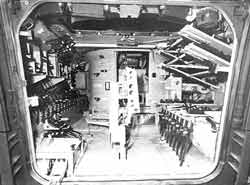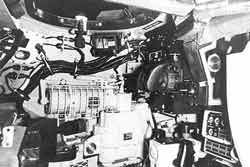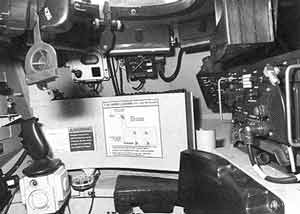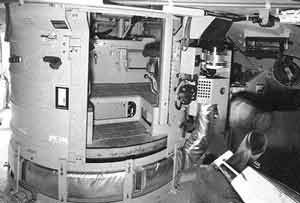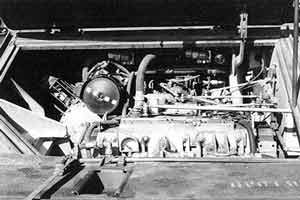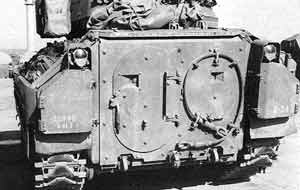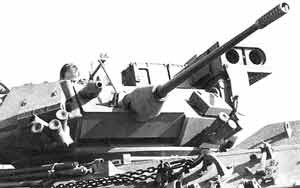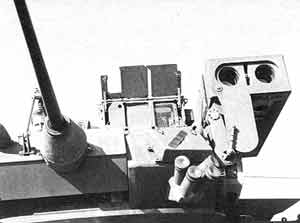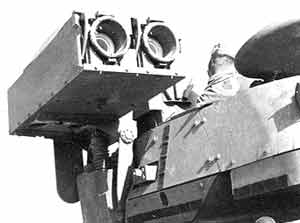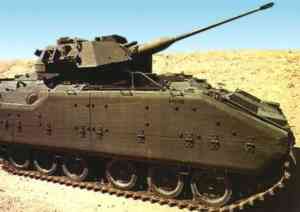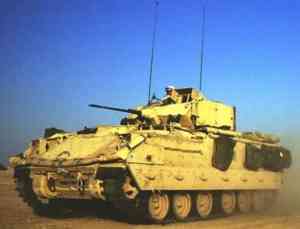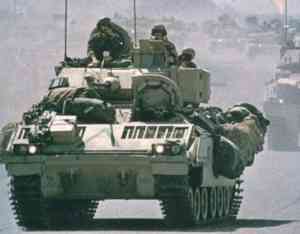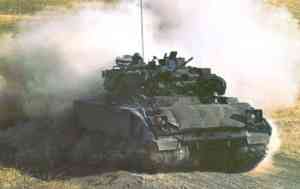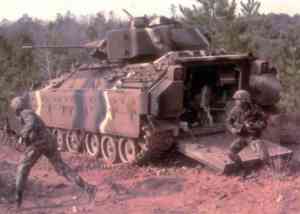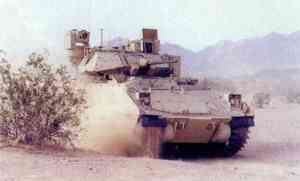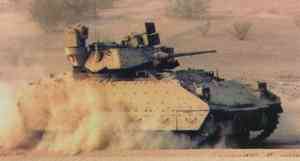| Designation: | Bradley M2/M3 |
 |
|---|---|---|
| Manufacturer: | BAE Systems Land and Armament | |
| Product type: | Armoured Vehicles | |
| Name: | Infantry fighting vehicle |
The Bradley Fighting Vehicle System includes the M2 Infantry Fighting Vehicle and the M3 Cavalry Fighting Vehicle. It is in service with the armies of the USA and Saudi Arabia. Since 1981, 6720 vehicles of both types have been fielded.
The role of the M2 Infantry Fighting Vehicle is to transport infantry on the battlefield, to provide fire cover to dismounted troops and to suppress enemy tanks and fighting vehicles. The M2 carries three crew, commander, gunner and driver plus six fully equipped infantry men. The M3 performs scout missions and carries three crew plus two scouts.
The US Army A3 Bradley upgrade programme includes improvements based on operational experience in the Gulf War. The first low-rate initial production M2A3/M3A3 Bradley was delivered in November 1998 and entered service in April 2000. The system is scheduled to enter full-rate production in 2001. More than 1000 vehicles are to be procured. The US Army has ordered two A3 FIST fire support team vehicles, which can conduct digital fire support co-ordination, laser designation of targets when stationary and target acquisition when on the move.
Upgraded target acquisition, automatic and dual target tracking and automated boresighting are being installed. The Improved Bradley Acquisition System (IBAS) with eyesafe laser rangefinder and Commander's Independent Thermal Viewer (CITV), both from Raytheon include thermal imagers based on a 480 x 4 scanning focal plane array. The thermal imaging Raytheon Driver's Vision Enhancer (DVE), AN-VAS-5, uses a 320 x 240 uncooled ferroelectric scanning array. A combat identification system is being installed. The electronics system includes a databus with central processors and digital information displays for commander, driver and squad leader.
The gunner is equipped with a Raytheon Integrated Sight Unit (ISU) which includes a day/thermal sight of magnification x4 and x12. An optical relay provides the image of the gunner's sight to the commander. The gunner also has periscopes for forward and side observation. A daytime sight system for the gunner or commander is provided as backup to the primary sight.
The driver is equipped with three forward periscopes plus one periscope to the left. The central periscope can be replaced with the Litton AN/VVS-2 Driver's Night Viewer with a 25 mm second generation image intensifier.
The main armament is a Boeing 25 mm M242 Bushmaster chain gun. The M242 has a single barrel with an integrated dual feed mechanism and remote feed selection. The gunner can select single or multiple shot mode. The standard rate of fire is 200 rounds/minute but the gun is optionally converted to 500 rounds per minute. An M240C 7.62 mm machine gun is mounted coaxially to right of the Bushmaster.
The M2 Bradley is equipped with the Raytheon TOW BGM-71 anti-tank missile system. The twin-tube TOW launcher is mounted on the left of the turret. The target is tracked using an optical sight which detects the infra-red signal from the back of the missile in flight. A double-wire command link between the missile and the gunner is dispensed from two spools at the back of the missile. The launcher sends flight correction data to the guidance system on the missile via the command link. The range of the TOW missile is 3.75 km.
The Bradley is equipped with two M257 smoke grenade dischargers, each loaded with four smoke grenades. It is also fitted with an engine smoke generating system.
The hull of the M2 is constructed of welded aluminium and spaced laminate armour. In addition, the M2A2/M3A2 Bradleys have applique steel armour with provision for additional passive armour or explosive reactive armour for increased protection against ballistic weapons.
The Bradley is equipped with a VTA-903T engine from Cummins Engine Co of Colombus, Indiana. The hydromechanical transmission HMPT-500 from Lockheed Martin provides three speed ranges. The engines provide a maximum speed of 66 km/hour.
All Bradleys are amphibious. Earlier models are equipped with a water barrier, which is fitted by the crew before entering the water. A3 models have an inflatable pontoon which fits on the front and sides of the vehicle. Water propulsion is provided by tracks and the Bradley can attain a maximum speed of 7.2 Km/hour in water.
|
||||||||||||||||||||||||||||||||||||||||||||||||||||||||||||||
|
|||||||||||||||
Related Articles |
|
RAVEN Countermeasure System protects vehicles from missile threats (15.10.2019) |
|
Raytheon, Rheinmetall form joint venture for US Army combat vehicle competition (02.10.2019) |
|
Raytheon, Rheinmetall join forces for US Army’s Next-Gen Combat Vehicle competition (14.10.2018) |
|
Bradley Driving… In Stereo (06.07.2018) |
|
BAE Systems receives U.S. Army contract to begin M109A7 full-rate production (23.12.2017) |
|
BAE Systems rolls out first Armored Multi-Purpose Vehicle (16.12.2016) |
|
BAE Systems debuting next generation Bradley prototype (06.10.2016) |
|
Contract for Bradley Fighting Vehicle Gunner's Hand Station (06.10.2016) |
|
Optex Systems Receives $841,000 in Initial Orders for Its Advanced Laser Protected Periscopes (23.04.2016) |
|
Saab to Provide Additional Deliveries for U.S. Army’s Combat Vehicles (15.01.2016) |
|
$245.3 Million U.S. Army Contract to Continue M109A7 Production (04.11.2015) |
|
BAE Awarded Contract to Begin AMPV Program (24.12.2014) |
|
BAE Systems To Continue M109A7 Production With $142 Million Follow-on Contract (09.11.2014) |
|
BAE Submits Bid for Highly Survivable, Affordable AMPV (02.06.2014) |
|
New Order to T&S for US Army's Combat Vehicles (07.12.2013) |


